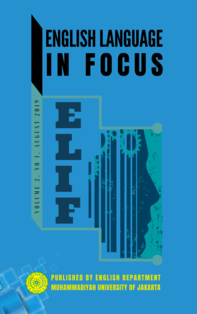Item Analysis for a Better Quality Test
DOI:
https://doi.org/10.24853/elif.2.1.59-70Keywords:
Item analysis, summative test, the difficulty level, the discriminating power, the effectiveness of distractors.Abstract
This study is a small-scale study of item analysis of a teacher’s own-made summative test. It examines the quality of multiple-choice items in terms of the difficulty level, the discriminating power, and the effectiveness of distractors. The study employed a qualitative approach which also used a simple quantitative analysis to analyze the quality of the test items through the document analysis of the teacher’s English summative test and the students’ answer sheets. The result shows that the summative test has more easy items than difficult items with the ratio of 19:25:6 while they should be 1:2:1 for easy, medium, and difficult. In terms of the Discriminating Power, there are 3, 13, and 16 for excellent, Good, and satisfactory level, but there are 17 and 2 for poor and bad levels of Discriminating Power. There are 43 (21.5%) of all distractors which are dysfunctional which, in turns, makes the items too easy which also makes the items fail to discriminate the upper-group students from the lower ones. Therefore, the 43 dysfunctional distractors should be revised to alter the difficulty level and improve the discriminating power. This research is expected to serve as a reflective means for teachers to examine their own-made test to ensure the quality of their test items.References
Afziyatin, P. (2018). An Item Analysis of the English Summative Test for the Eleventh Grade Students of SMAN 90 Jakarta in the Second Semester of 2017/2018 Academic Year. An unpublished paper. Universitas Muhammadiyah Prof. DR. Hamka.
Arikunto, S. (1986). Dasar-Dasar Evaluasi Pendidikan. Jakarta: Bumi Aksara.
Bachman, L. F., & Palmer, A. S. (1996). Language Testing in Practice: Designing and Developing Useful Language Tests. New York: Oxford University Press.
Brown, H. D. (2003). Language Assessment: Principles and Classroom Practices. New York: Pearson Longman.
Brown, J. D. (1996). Testing In Language Programs: A Comprehensive Guide To English Language Assessment. Upper Saddle River: Prentice Hall Regents.
Brown, J. D., & Hudson, T. (2002). Criterion-referenced Language Testing. Cambridge: Cambridge University Press.
Burton, S. J., Sudweeks, R. R., Merrill, P. F., & Wood, B. (1991). How to Prepare Better Multiple-Choice Test Items: Guidelines for University Faculty. Retrieved from https://testing.byu.edu/handbooks/betteritems.pdf
Cizek, G. J. (2010). An Introduction to Formative Assessment. In H. L. Andrade & G. J. Cizek (Eds.), Handbook of Formative Assessment (pp. 3–17). New York: Routledge.
EDC. (2013). Understanding Evaluation: Promote Prevent- 3 Bold Steps. Retrieved from Education Development Centre, Inc. website: http://positiveschooldiscipline.promoteprevent.org/
Fulcher, G., & Davidson, F. (2007). Language Testing and Assessment: An Advanced Resource Book. New York: Routledge.
Gronlund, N. E. (1977). Constructing Achievement Tests (2nd ed.). https://doi.org/10.1002/tea.3660060216
Harmer, J. (2007). The Practice of English Language Teaching. England: Pearson Education Limited.
Heaton, J. B. (1988). Writing English Language Tests: A Practical Guide for Teachers of English As a Second or Foreign Language. London: Longman.
Hughes, A. (2003). Testing for Language Teachers (2nd ed.). UK: Cambridge University Press.
Malau-Aduli, B. S., & Zimitat, C. (2012). Peer Review Improves the Quality of MCQ Examinations. Assessment & Evaluation in Higher Education, 37(8), 919–931. https://doi.org/10.1080/02602938.2011.586991
Musial, D., Nieminen, G., Thomas, J., & Burke, K. (2009). Foundations of Meaningful Educational Assessment. New York: McGraw-Hill Higher Education.
Patton, M. Q. (1987). Qualitative Research & Evaluation Methods. Thousand Oaks, CA: Sage Publications.
Popham, W. J. (2003). Test Better, Teach Better: The Instructional Role of Assessment. Virginia-USA: Association for Supervision and Curriculum Development.
Professional Testing Inc. (2006). Step 9. Conduct the Item Analysis. Retrieved from http://www.proftesting.com/test_topics/pdfs/steps_9.pdf
Reynolds, C. R., & Livingston, R. B. (2012). Mastering Modern Psychological Testing: Theory and Methods. Upper Saddle River, NJ: Pearson Education.
Shinkfield, A. J., & Stufflebeam, D. L. (1995). Teacher Evaluation: Guide to Effective Practice. London: Kluwer Academic Public.
Weir, C. J. (2005). Language Testing and Validation An Evidence-based Approach (C. N. Candlin & D. R. Hall, Eds.). New York: Palgrave Macmillan.
Zajda, J. (2006). Learning and Teaching. Australia: James Nicholas Publisher Pty Ltd.
Downloads
Published
Issue
Section
License
Authors who publish with this journal agree to the following terms:
- Authors retain copyright and grant the journal right of first publication with the work simultaneously licensed under a Creative Commons Attribution License that allows others to share the work with an acknowledgment of the work's authorship and initial publication in this journal.
- Authors can enter into separate, additional contractual arrangements for the non-exclusive distribution of the journal's published version of the work (e.g., post it to an institutional repository or publish it in a book), with an acknowledgment of its initial publication in this journal.
- Authors are permitted and encouraged to post their work online (e.g., in institutional repositories or on their website) before and during the submission process, as it can lead to productive exchanges, as well as earlier and greater citation of published work (See The Effect of Open Access).


